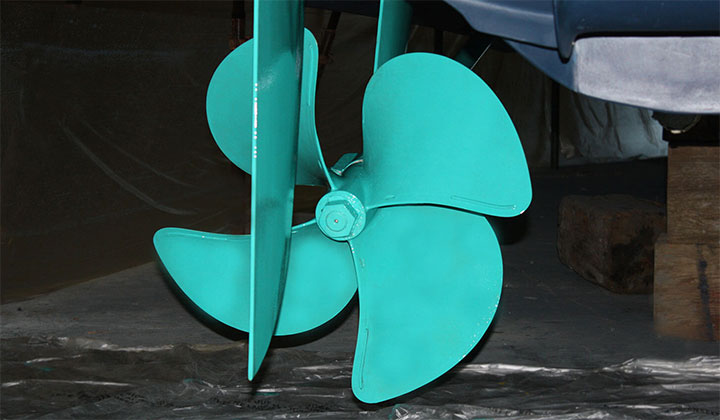Anti-fouling - new technologies make it easier
Chris Hogan, 8th April 2016, Boat
Anti-fouling paint and coverings - stripping down and reapplying it is a regular chore for boat and yacht owners, sometimes annual. Fouling can be worse in some areas than others and there'll be different issues to deal with too - mainly shellfish, slime and weeds - often all three!

Image shows AquaCote Prop on a Princess 48, courtesy AquaCote.
Not many people have kind words to say about anti-fouling products - everyone seems to agree that although they're better than nothing, they don't seem to work that well. But it is essential as the drag decreases efficiency and saps performance.
Choosing the right one is part of the problem - there's a huge range and which one will work best depends on where you are in the UK, where and how you use your boat and how often it's in the water. A good method is to canvas opinion wherever you keep or use your boat to find out what products other local people are using and what they think of them.
The environmental issue complicates matters as well - copper is used in many coverings but is toxic to marine life and is being banned in many locations.
Nanotechnology?
But there are new products coming to market using nanotechnology and other technologies that are claimed to be a lot more effective at keeping marine life at bay. The term 'nanotechnology' refers to engineering with very small units - between around 1 to 100 nanometres. To put that in context a human hair is about 80,000 nanometres across.
At these tiny sizes molecules behave differently and can be constructed in different ways, giving us a new man-made materials. The use of nanotechnology in anti-fouling paints allows chemists to create custom coatings in a way they haven't been able to before.
What does it give us?
There are two companies currently talking about new technology in use for anti-fouling products - Nanotech Marine and AcquaCote Marine.
Nanotech Marine launched the Nano-it brand at the London Boat Show, working with an American company that wanted to enter the UK retail market.
Anti-foul is just one of the uses though. Nanotechnology allows them to formulate compounds for very specific uses, for example a product that can restore anodised aluminium like the frames on some cabin windows. Another is coatings that are exceedingly hydrophobic and can be applied to hard surfaces to drive water away - painted surfaces and glass, for example.
AquaCote Marine
Aquacote's new product has been in development for eight years and was launched to the trade last year at METSTRADE 2015 - the world's largest marine equipment trade show. It takes a different tack, using silicon-based technology.
The new product is very tough, suitable for a wide range of hulls, easy to apply and it's claimed that slime can just be wiped off. A test customer with a 56 Oyster was quoted as saying that they "had to take it easy going through the marina because she felt so slick going through the water."
The product isn't available for retail just yet - AcquCote say that it is finalising packaging, electronic brochures and redeveloping the website for the new product. As soon as we hear that it's in the shops we'll let you know.
The age old job
Both of these new technological approaches to an age-old problem sound very promising and they may also deal with the copper toxicity problem too.
But one thing is certain - neither of these new approaches will help with one of most hated jobs in boating - scraping off the old coating!
Related articles
Monthly Newsletter
Not signed up to our monthly newsletters and would like to keep up to date with a variety of products? Select from below which products you would like to receive.
No Product! Please select a product